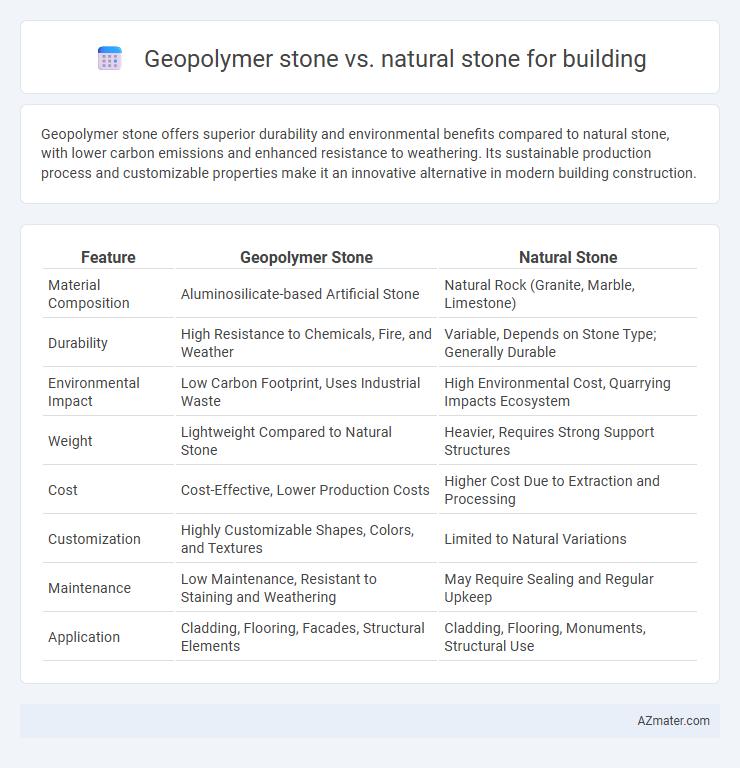Geopolymer stone offers superior durability and environmental benefits compared to natural stone, with lower carbon emissions and enhanced resistance to weathering. Its sustainable production process and customizable properties make it an innovative alternative in modern building construction.
Table of Comparison
| Feature | Geopolymer Stone | Natural Stone |
|---|---|---|
| Material Composition | Aluminosilicate-based Artificial Stone | Natural Rock (Granite, Marble, Limestone) |
| Durability | High Resistance to Chemicals, Fire, and Weather | Variable, Depends on Stone Type; Generally Durable |
| Environmental Impact | Low Carbon Footprint, Uses Industrial Waste | High Environmental Cost, Quarrying Impacts Ecosystem |
| Weight | Lightweight Compared to Natural Stone | Heavier, Requires Strong Support Structures |
| Cost | Cost-Effective, Lower Production Costs | Higher Cost Due to Extraction and Processing |
| Customization | Highly Customizable Shapes, Colors, and Textures | Limited to Natural Variations |
| Maintenance | Low Maintenance, Resistant to Staining and Weathering | May Require Sealing and Regular Upkeep |
| Application | Cladding, Flooring, Facades, Structural Elements | Cladding, Flooring, Monuments, Structural Use |
Introduction to Geopolymer Stone and Natural Stone
Geopolymer stone is an engineered material made from industrial by-products like fly ash and slag, offering high durability, eco-friendliness, and resistance to chemicals and heat. Natural stone, such as granite, marble, and limestone, is quarried directly from the earth, prized for its unique aesthetics, natural textures, and long-lasting strength. Both materials serve as durable building solutions, with geopolymer stone providing sustainable alternatives to traditional natural stone in modern construction.
Composition and Formation Processes
Geopolymer stone is synthesized from industrial by-products like fly ash and slag, undergoing an alkaline activation process that results in a chemically bonded, durable material. Natural stone forms through geological processes such as sedimentation, metamorphism, or volcanic activity, resulting in minerals compacted and cemented over millions of years. The distinct difference in formation leads to geopolymer stone having more controlled composition and enhanced environmental sustainability compared to the variable mineral content of natural stone.
Environmental Impact and Sustainability
Geopolymer stone significantly reduces carbon emissions compared to natural stone by utilizing industrial byproducts such as fly ash and slag, minimizing the depletion of natural resources. Its production consumes less energy and produces fewer greenhouse gases, enhancing sustainability in the building sector. Unlike natural stone quarrying, geopolymer manufacturing reduces habitat destruction and land degradation, making it a more eco-friendly choice for sustainable construction.
Durability and Longevity Comparison
Geopolymer stone exhibits superior durability compared to natural stone due to its enhanced resistance to chemical corrosion, freeze-thaw cycles, and environmental degradation. Its engineered composition allows for consistent strength and structural integrity over time, resulting in longer-lasting building materials. Natural stone, while aesthetically appealing and strong, is more susceptible to weathering and erosion, potentially reducing its lifespan in harsh conditions.
Mechanical Properties and Strength
Geopolymer stone exhibits superior compressive strength and enhanced durability compared to many types of natural stone, making it highly suitable for structural applications in building construction. Its high resistance to chemical attack and thermal stability further contribute to its mechanical robustness, outperforming traditional natural stones like limestone and granite in harsh environments. The controlled manufacturing process allows for consistent quality and tailored mechanical properties, providing architects and engineers with a reliable alternative to natural stone.
Aesthetic Differences and Design Flexibility
Geopolymer stone offers a diverse range of colors and textures that can be precisely engineered, providing superior design flexibility compared to natural stone, which has limited variation due to its geological origins. The consistent quality and uniform appearance of geopolymer stone enable architects to create innovative and intricate patterns that are difficult to achieve with the irregularities and natural veining of natural stone. While natural stone provides an authentic and unique aesthetic with rich historical appeal, geopolymer stone allows customization for modern architectural designs requiring specific visual effects and enhanced surface finishes.
Cost Analysis: Upfront and Lifecycle
Geopolymer stone offers a lower upfront cost compared to natural stone due to its synthetic production process that uses industrial by-products and requires less quarrying and transportation. Lifecycle costs also favor geopolymer stone because of its higher durability, resistance to weathering, and reduced maintenance needs, resulting in long-term savings for building projects. In contrast, natural stone involves higher initial investment and ongoing expenses related to sealing, repairs, and potential environmental impact mitigation.
Installation Methods and Practical Considerations
Geopolymer stone installation involves lightweight panels that simplify handling and reduce labor costs compared to the heavier, more brittle natural stone slabs requiring skilled masons and heavy equipment. Geopolymer stone offers consistent dimensions allowing for easier cutting and faster adhesive bonding, whereas natural stone often demands mechanical anchoring and precise fitting due to irregularities. Practical considerations favor geopolymer for projects emphasizing sustainability and speed, while natural stone remains preferred for traditional aesthetics and proven durability under extreme weather conditions.
Maintenance Requirements and Weather Resistance
Geopolymer stone offers superior weather resistance due to its enhanced chemical stability and reduced porosity, making it less susceptible to erosion, freeze-thaw cycles, and staining compared to natural stone. Maintenance requirements for geopolymer stone are minimal, often limited to occasional cleaning, whereas natural stone demands regular sealing and more frequent repairs to address cracking, efflorescence, and surface degradation. The durability of geopolymer stone under harsh environmental conditions makes it a cost-effective and low-maintenance alternative for long-term building applications.
Future Trends and Innovations in Stone Construction
Geopolymer stone offers significant advantages over natural stone in building due to its sustainability, enhanced durability, and lower carbon footprint, driving future trends toward eco-friendly construction materials. Innovations in geopolymer technology enable customizable properties, such as improved fire resistance and thermal insulation, enhancing building performance compared to traditional natural stone. Continued research in nanotechnology and material science promises further advancements in geopolymer composites, positioning them as a leading alternative for modern and resilient stone construction.

Infographic: Geopolymer stone vs Natural stone for Building
 azmater.com
azmater.com